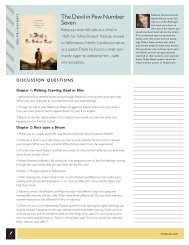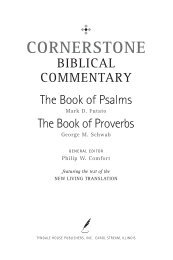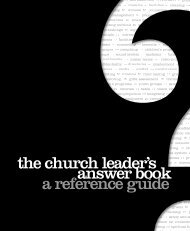Cornerstone Biblical Commentary: Luke and Acts - Tyndale House ...
Cornerstone Biblical Commentary: Luke and Acts - Tyndale House ...
Cornerstone Biblical Commentary: Luke and Acts - Tyndale House ...
Create successful ePaper yourself
Turn your PDF publications into a flip-book with our unique Google optimized e-Paper software.
LUKE 4<br />
taken from eyewitnesses <strong>and</strong> ministers of the word (1:2-4). Second, he appears to<br />
view himself as a companion of Paul in the “we” sections of <strong>Acts</strong> (<strong>Acts</strong> 16:10-17;<br />
20:5-15; 21:1-18; 27:1–28:16). This latter feature reduces the search for possible<br />
authors.<br />
Some critics view the “we” sections simply as a literary device designed to create<br />
the effect or impression of an eyewitness (Haenchen, Pervo). The picture of Paul<br />
in <strong>Acts</strong> is also contrasted with the self-portrait drawn in the Pauline epistles, both in<br />
terms of its historical accuracy <strong>and</strong> its theological characteristics. Such arguments<br />
have led a few writers to deny that the author of the third Gospel was a companion<br />
of Paul (Vielhauer, Robbins). However, the connection of <strong>Luke</strong> as a traveling companion<br />
of Paul has been ably defended by Fitzmyer, who has argued that a creative<br />
literary device does not offer an adequate explanation of the appearance <strong>and</strong> disappearance<br />
of the “we” sections in such a capricious manner (Fitzmyer 1989:16-<br />
22). In addition, some “sailing” references lack the “we” terminology, though they<br />
would be suitable insertions if the aim were just to increase the impression of vividness<br />
(e.g., <strong>Acts</strong> 13:4, 13; 14:26; 17:14; 18:18, 21).<br />
In fact, a strong case has been made that the portrait of Paul in his epistles should<br />
be seen as compatible with that presented in <strong>Acts</strong> (Bruce 1962:24-27). According to<br />
the internal evidence of <strong>Luke</strong>–<strong>Acts</strong>, it is reasonable to conclude that the author was<br />
personally acquainted with Paul as a traveling companion <strong>and</strong> was most probably a<br />
second-generation Christian. He was committed to the task of communicating the<br />
Good News in an accurate <strong>and</strong> responsible manner.<br />
His prologue is unique among the Gospels <strong>and</strong> displays an elevated literary style<br />
that is clearly reminiscent of the classical historians of the ancient world like<br />
Thucydides, Polybius, <strong>and</strong> Herodotus (Talbert 1989:7-11; Winter <strong>and</strong> Clarke<br />
1993:1-29). However, the most illuminating parallels to the prologue are probably<br />
the prefaces of Josephus in his two-volume work Against Apion, discussed in the<br />
notes on 1:1-4. To sum up, <strong>Luke</strong> stacks up well against his contemporaries as a<br />
responsible historian of Christian origins.<br />
For the modern reader of <strong>Luke</strong>’s Gospel, it is interesting <strong>and</strong> significant that<br />
there are three helpful references to <strong>Luke</strong> in the New Testament. He is mentioned<br />
in Philemon when Paul sends greetings to Philemon from Epaphras, a fellow prisoner,<br />
<strong>and</strong> then adds similar greetings from Mark, Aristarchus, Demas, <strong>and</strong> <strong>Luke</strong>,<br />
who are described appreciatively as “co-workers” (Phlm 1:24). The second reference<br />
is found in Colossians, where greetings are given from a group including<br />
Epaphras, <strong>Luke</strong>, <strong>and</strong> Demas (Col 4:10-14). There, <strong>Luke</strong> is explicitly described as<br />
“the beloved physician” (Col 4:14, KJV) <strong>and</strong> is listed with Christian colleagues<br />
who were Gentiles (the Jewish believers are listed in Col 4:11), making it probable<br />
that he, too, was a Gentile. The third reference to <strong>Luke</strong> appears in 2 Timothy, where<br />
once more Paul is in prison <strong>and</strong> notes rather plaintively, “Only <strong>Luke</strong> is with me”<br />
(2 Tim 4:11). 3 Evidently, Paul valued the help <strong>and</strong> support of <strong>Luke</strong> as a trusted<br />
confidant <strong>and</strong> aide.<br />
In addition to these direct references to <strong>Luke</strong>, there are several “we” passages in
















